Vertical AI agents, unlike general-purpose AI tools, are trained to take action inside specific business workflows like sales, recruiting, or support. In 2025, tools like Lindy (for sales and operations) and Suki AI (for clinical documentation in healthcare) are helping teams automate domain-specific tasks with more reliability than general models.
Let’s see what we’ll talk about in this blog:
- What are vertical AI agents and how do they work?
- Popular use cases
- The top platforms for vertical AI agents
- How to choose the right AI platform
First, let’s clarify the meaning of vertical SaaS, since it’s the foundation for understanding how vertical AI agents evolved.
What are vertical AI agents?
A vertical AI agent is an AI system built to handle tasks within a specific industry (called a “vertical”) — like sales, recruiting, customer service, or healthcare. It’s not a general-purpose chatbot or assistant. It’s a task-focused, role-aware agent that understands the tools, language, and workflows of a particular domain.
A vertical AI agent can complete tasks like sending follow-ups to leads, qualifying job applicants, responding to support tickets, or documenting a medical visit. It works inside your existing stack like your inbox, CRM, EHR, or calendar, and acts on your behalf based on the goals you set.
Let’s dig into how these agents differ from the traditional tools we’ve likely been using.
Vertical SaaS vs. vertical AI agents
SaaS are your everyday tools, like Slack or Google Workspace. Here’s a side-by-side comparison:
General AI vs. verticalized intelligence
General AI is used in tools like Claude, Gemini, or ChatGPT. Verticalized intelligence focuses on specific industries or domains like sales, support, or healthcare. These tools are fine-tuned for contextual understanding and common industry workflows. Here’s how they compare:
LLMs vs vertical AI agents
LLMs are the models behind AI. We compare them with vertical AI agents and plugins/copilots:
Next, we understand why these are becoming so popular.
Why is vertical AI exploding in 2025?
Vertical AI has become the go-to phrase in VC memos, founder pitches, and AI roadmaps. We’re at a point where three big shifts have come together at once:
- LLMs are getting better at tool use: Instead of responding with words, agents can now take structured actions — like updating your CRM, sending emails, or pulling live data from your systems.
- Agent memory and task planning have improved: This means agents can now work across multi-step flows, keep context over time, and even hand off tasks to one another.
- Domain-specific datasets are becoming more available: Companies are training agents on industry language, process logic, and task patterns.
Put those three together, and you get agents that can close loops, manage workflows, and deliver results inside vertical applications.
Investors are paying close attention. Several leading VCs have highlighted vertical AI agents as a transformative shift — with the potential to significantly impact traditional SaaS models by embedding AI deeply within workflows.
And that speaks to a deeper pain across industries. Companies aren’t looking for more tools. They’re looking for outcomes. A sales leader wants more meetings booked. A recruiter wants top candidates already screened and followed up with.
That’s why vertical platforms powered by AI agents are suddenly moving from prototype to production.
Next, we compare them with SaaS, plugins, and general AI.
Vertical AI agents vs SaaS, plugins, and workflows
To see what makes vertical AI agents different, we compare them to the tools most teams are already using — SaaS apps and general AI tools.
Here’s how they compare side-by-side:
With enough context, let’s now understand how they work.
How do vertical AI agents work?
Vertical AI agents are made up of three components. They are:
- Embedded LLMs: These power the agent’s understanding of natural language, letting it interpret context, intent, and tasks without needing fixed input formats.
- Memory and reasoning loop: Agents can recall past interactions, make decisions based on goals, and update their plan as they move through a task. This enables them to go beyond single-step actions and complete multi-step workflows.
- Tool execution: Agents can take real action — updating a CRM, pulling a record from your EHR, sending an email, or navigating a website — through direct API calls or browser-based actions.
All of this runs inside your existing tools –– whether it’s a sales agent updating lead statuses inside your CRM or a recruiting agent scheduling interviews via your calendar.
That’s how it differs from traditional automation. You’re not building brittle workflows with if/then logic. These AI verticals can learn, adapt, and act based on the inputs they get.
The technical scaffolding can vary, but common stacks include orchestration libraries like LangChain or CrewAI, agent strategies like ReAct, and platform-specific wrappers. Some platforms, like Lindy, offer this all-in-one — including memory, action modules, and real-time integrations — to deploy agents inside real workflows.
We now know vertical AI agents. Next, let’s discover some of their applications.
Top use cases for vertical AI agents
Vertical AI agents can seamlessly operate inside specific workflows. Below are some of the clearest use cases across different SaaS verticals:
Sales
AI agents in sales automate the boring stuff –– prospecting, CRM hygiene, and follow-ups. A sales agent can scan a list, enrich leads, draft outreach messages, and update deal stages based on replies. From there, it can nudge reps or even book meetings directly.
It not only saves time, but it also drives the pipeline without needing more headcount. Tools like Lindy and Regie.ai can aid sales teams to automate processes.
Customer support
Support teams use vertical AI to triage tickets, tag intents, and even respond directly — all within helpdesks like Zendesk or Intercom. Agents can escalate complex queries or loop in humans when needed, but for FAQs and simple issues, they are capable of handling them.
This leads to faster resolutions and frees up reps for higher-value conversations. Tools like Zendesk AI, Lindy, and Forethought excel at this.
Healthcare
In clinical settings, vertical agents function as virtual scribes — listening during patient visits, transcribing key details, and updating the EHR. Some are voice-controlled, while others run in the background.
It results in less charting, better notes, and fewer hours spent on documentation after hours.
Suki and Lindy stand out here.
Recruiting
Recruiting agents source candidates, personalize outreach, qualify based on role fit, and even follow up to schedule interviews. These agents act like SDRs for hiring — minus the bandwidth constraints.
Tools like Metaview can boost your recruiting workflows.
Marketing and ops
Operations teams use AI agents to automate reporting, clean up inboxes, and trigger alerts across systems. In marketing, agents help with campaign summaries, audience segmentation, and coordination between tools like Sheets, Slack, and CRMs.
To boost the speed and efficiency of your marketing workflows, look for platforms like Lindy and Clay.
Next, some more tips that’ll help you choose the right AI platform.
Extra tips for choosing a vertical AI platform
Not all AI platforms are built the same — especially when it comes to vertical applications. Start by matching the platform to your core use case. Here are a few tips to help you out:
- For sales or recruiting teams, look for agents that specialize in outreach, CRM updates, or interview scheduling.
- For support or healthcare, task-specific context and language handling matter more.
- Match your technical comfort. Some platforms are no-code, while others assume you'll write prompts or stitch together logic using APIs or low-code frameworks.
- Prioritize platforms that offer a knowledge base (context/memory for agents), a large integrations library, and multi-step reasoning.
With enough knowledge about vertical AI agent platforms, let’s explore the 10 best platforms of 2025.
Top 9 vertical AI agent platforms in 2025
We looked for platforms that suited different applications across industries. Here are the top tools:
- Lindy – Best for no-code automation across sales and operations
- Relevance AI – Best for customizable workflows
- Botpress – Best for developer-led chatbot deployment
- Beam – Best for multi-agent task orchestration
- Vertex Agent Builder – Best for building agents on enterprise infrastructure
- OpenAI Assistants API – Best for building custom AI assistants into apps
- Make – Best for no-code automation builders
- Suki AI – Best for clinical documentation and medical scribing
- Zendesk AI – Best for AI-powered customer support automation
Next, let’s study them in detail.
1. Lindy – Best for no-code automation across sales and operations
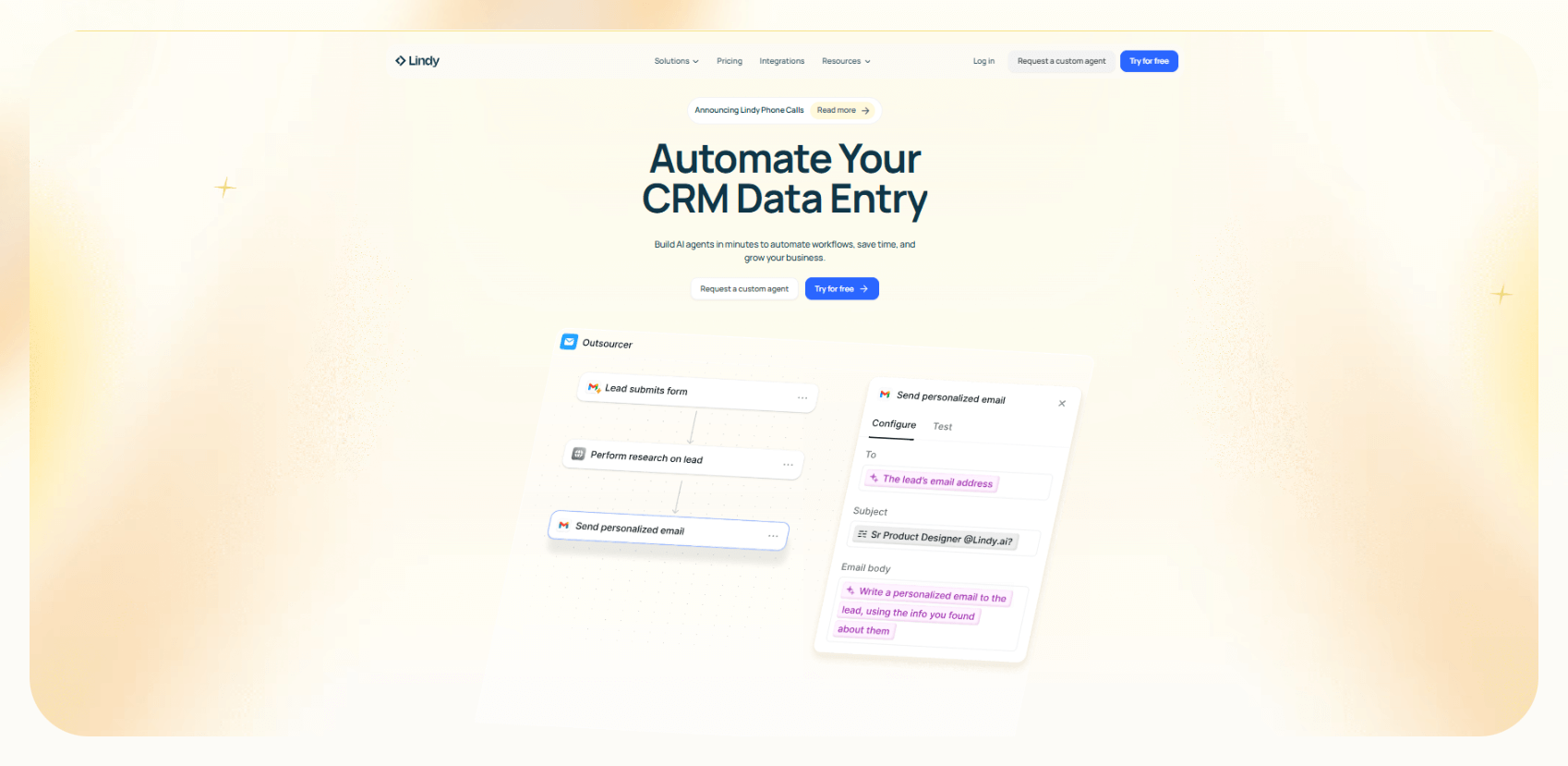
Lindy is a no-code platform for building AI agents that automate tasks across sales, support, recruiting, and healthcare. It’s built for operators who want control without needing to write code.
Users can create agents to handle things like outbound calling, inbox triage, meeting scheduling, lead qualification, or even responding to customer emails. Lindies can be customized through a visual builder, and they work across tools like CRMs, calendars, and Slack.
It's ideal for teams looking to replace repetitive workflows with intelligent, task-specific automations.
Key features
- Drag-and-drop AI agent builder
- Role-specific templates –– sales rep, recruiter, scribe, and more
- Multi-agent workflows with a knowledge base and decision logic
- Support for 30+ languages for voice calling
Integrations
- Native support for Gmail, HubSpot, Salesforce, Slack, Notion, Twilio, and more
- API and webhooks for custom workflows
- Supports over 7,000 integrations across 1,600+ apps through Pipedream, Zapier, native APIs, and no-code connectors.
Pricing
- Free plan with 400 credits/month
- Pro: $49.99/month (5,000 credits)
- Business: $299.99/month (30,000 credits, premium features)
{{templates}}
2. Relevance AI – Best for customizable workflows
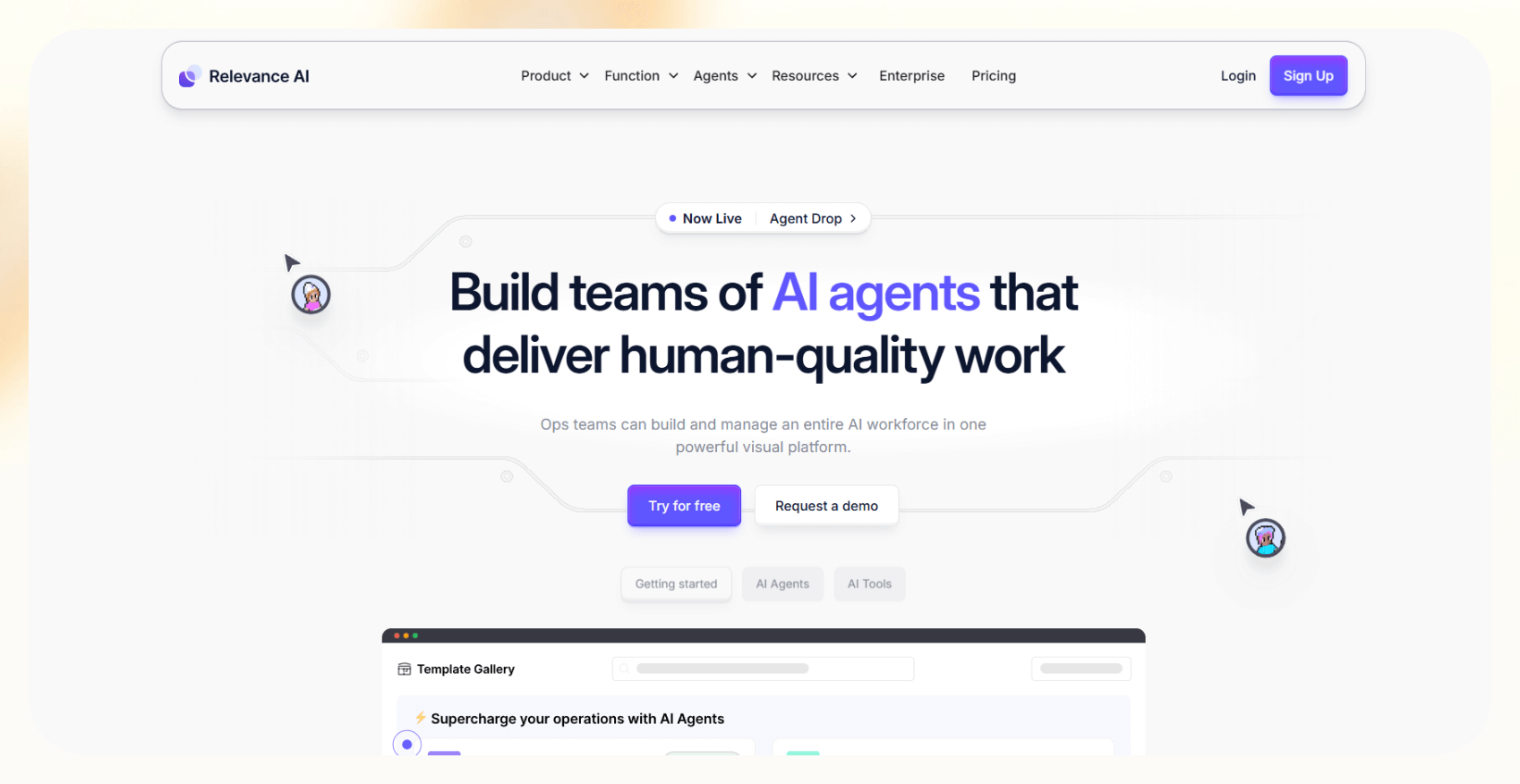
Relevance AI is a low-code platform designed to help teams build and deploy tailored AI workflows using agents.
It's built for companies that need more flexibility than basic automations, offering tools to build multi-step flows that combine natural language processing, data enrichment, and dynamic decision-making. You can create internal tools, dashboards, or customer-facing applications using a mix of AI agents and logic blocks.
Relevance AI is popular among ops, marketing, and analytics teams that want a modular, AI-powered way to automate decisions and tasks.
Key features
- Visual workflow builder with drag-and-drop components
- Dynamic pricing and scoring agents
- Built-in dashboards for analytics and evaluation
Integrations
- 2000+ integrations in total
- Native support for Airtable, Slack, Google Sheets, and other tools via connectors
Pricing
- Free plan available
- Paid plans start from $19/month, billed monthly
3. Botpress – Best for developer-led chatbot deployment
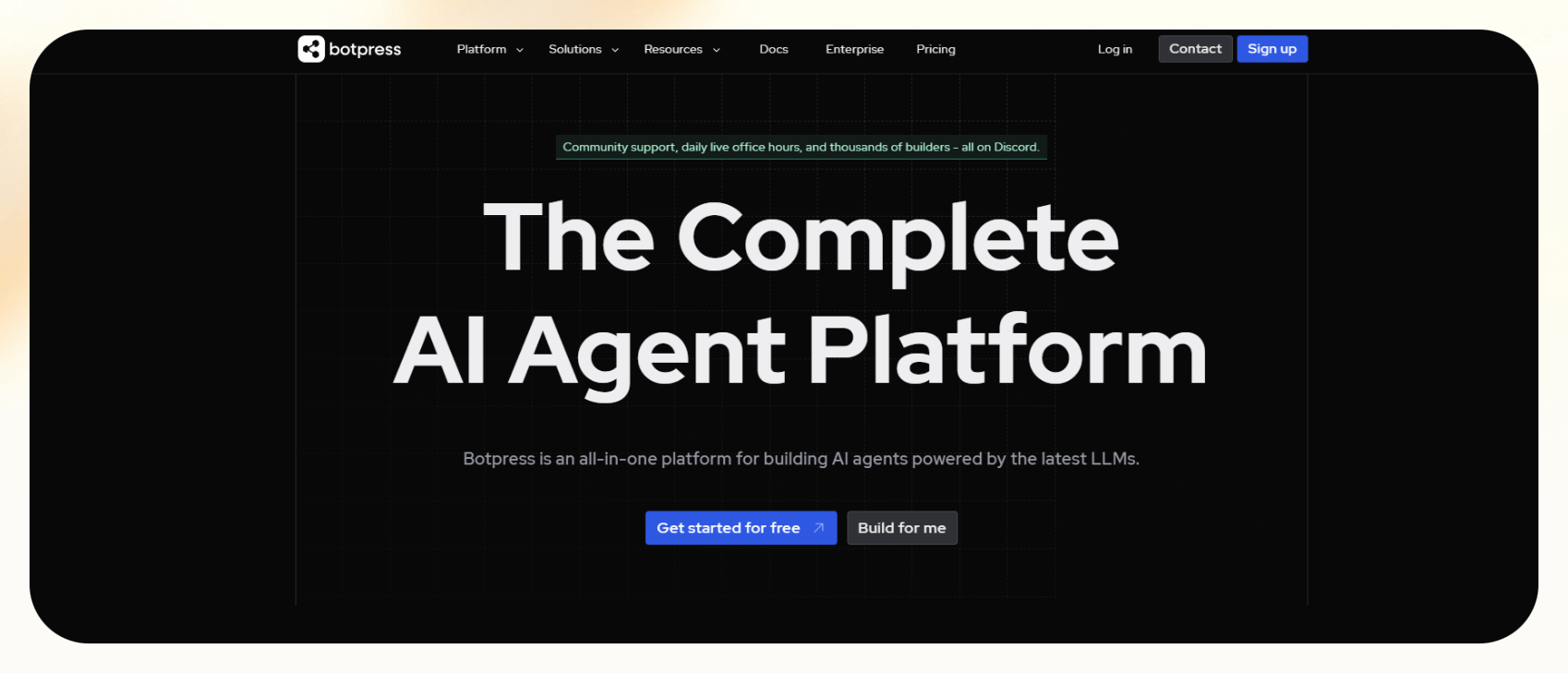
Botpress is an open-source platform for building conversational AI agents. It’s designed for technical teams that want full control over an AI bot’s behavior, logic, and deployment.
Botpress gives developers access to an SDK, modular architecture, and a real-time testing environment. It supports multi-channel deployment (web, Slack, Messenger, etc.) and lets you store conversations, define flows, and integrate external APIs.
It's a strong choice for teams building custom AI assistants for support, onboarding, or internal tools.
Key features
- Flow-based visual editor with natural language understanding
- Open-source with full SDK and CLI support
- Real-time emulator and debugging tools
- Modular plugin system for extensions
Integrations
- A total of 36 integrations
- Native support for messaging platforms and webhooks
Pricing
- Starts free, paid plans from $89/month, billed monthly
4. Beam – Best for multi-agent task orchestration
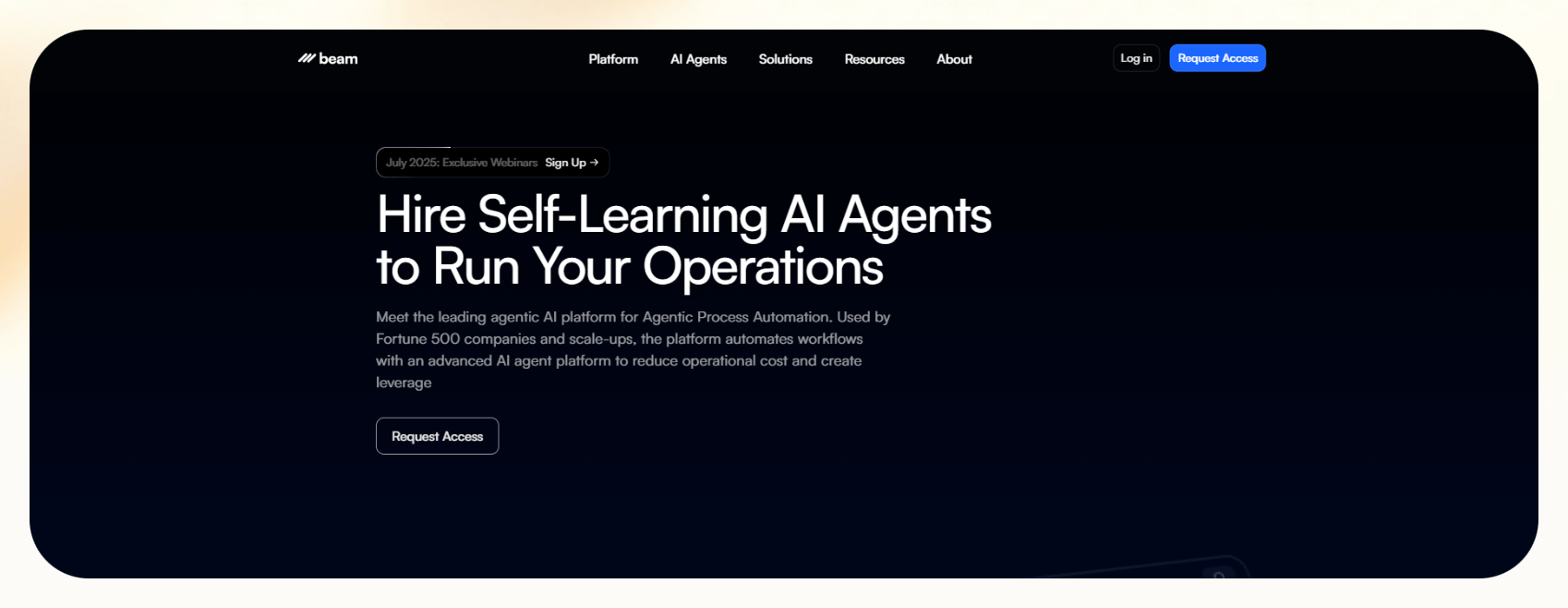
Beam is a platform that helps you design, test, and deploy AI workflows powered by multiple agents. It's built for companies that need complex task coordination — think of it as infrastructure for agent-to-agent collaboration.
Beam lets you define goals, assign responsibilities to agents, and monitor how tasks are completed end-to-end. You can run workflows that involve reasoning, memory, tool use, and inter-agent communication.
It's a good fit for R&D teams, operations, or any business exploring agentic workflows beyond single-step automations.
Key features
- Multi-agent planning and coordination engine
- Visual canvas for designing agent flows
- Built-in observability and debugging tools
- Support for long-running, stateful agents
Integrations
- REST APIs and function-calling support
- Agent plugins can interact with external apps, custom APIs, and internal tools
- 250+ integrations
Pricing
- Custom pricing
- Early access via waitlist
5. Vertex Agent Builder – Best for building agents on enterprise infrastructure
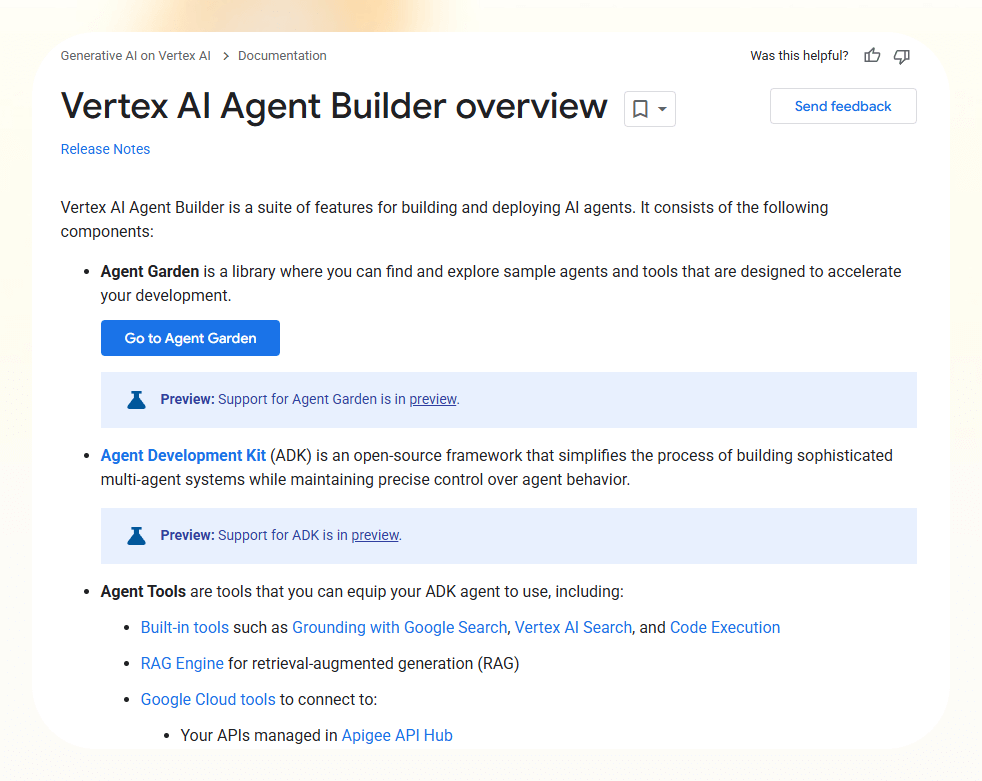
Vertex AI Agent Builder is Google Cloud’s platform for creating conversational and task-based AI agents. It’s for enterprises that need scalable, secure AI solutions built on Google’s infrastructure.
Users can design agents with a no-code interface, integrate them with internal data sources, and deploy them across channels like web, mobile, and messaging platforms.
It’s used in industries like automotive, finance, and fast-food outlets to build domain-specific assistants for customer support, ordering, and more.
Key features
- No-code agent builder with prompt chaining and context windows
- Support for actions, memory, and tool integration
- Access to Gemini models and grounding APIs
- Fully managed hosting on Google Cloud
Integrations
- Native support for Google Cloud ecosystem (BigQuery, Dialogflow, Cloud Storage, etc.)
- API and webhook support for custom tool access
- Integration count not specified, but strong integration with Google Cloud Platform
Pricing
- Pay-as-you-go based on usage (API calls, compute, model selection)
6. OpenAI Assistants API – Best for building custom AI assistants into apps
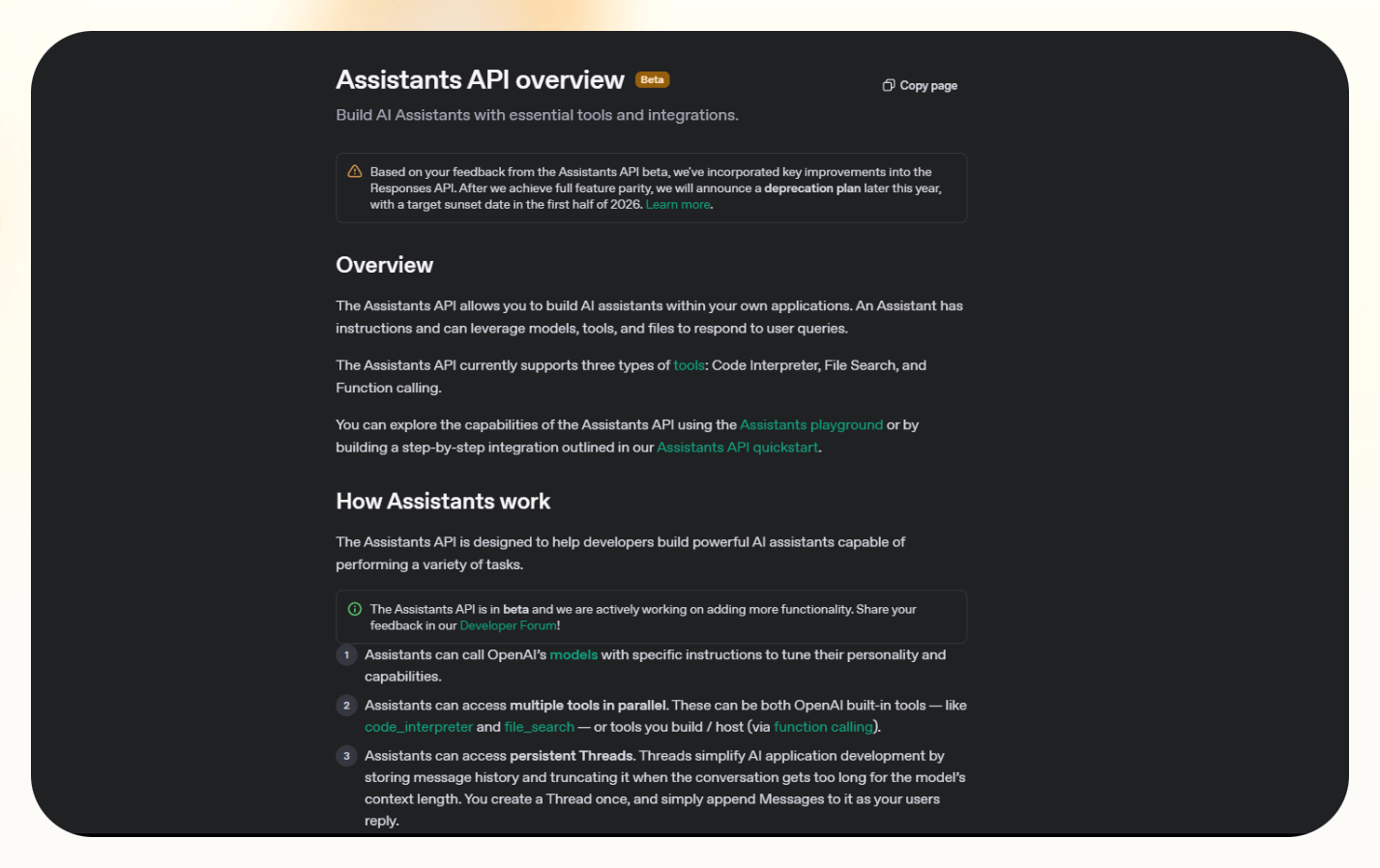
OpenAI Assistants API lets developers embed GPT-powered assistants into their apps with memory, function calling, and thread-based interactions. It’s aimed at product teams and startups building tools like helpbots, research assistants, or AI copilots.
The Assistants API supports long-term memory, tool execution, and code interpretation — all wrapped in a single API. It’s flexible but designed for developers to be comfortable handling prompts, functions, and state management.
Key features
- Persistent conversation threads with file support
- Function calling to interact with tools and data
- Support for image and code interpretation (via Code Interpreter)
- Hosted on OpenAI’s infrastructure
Integrations
- Custom integrations via API — developers define all tool and system connections
Pricing
- Pay-as-you-go based on model usage
- For example, you’ll pay $5.00/1M input tokens, $2.50/1M cached input tokens, $20.00/1M output tokens for GPT4o’s text capabilities
7. Make – Best for no-code automation builders
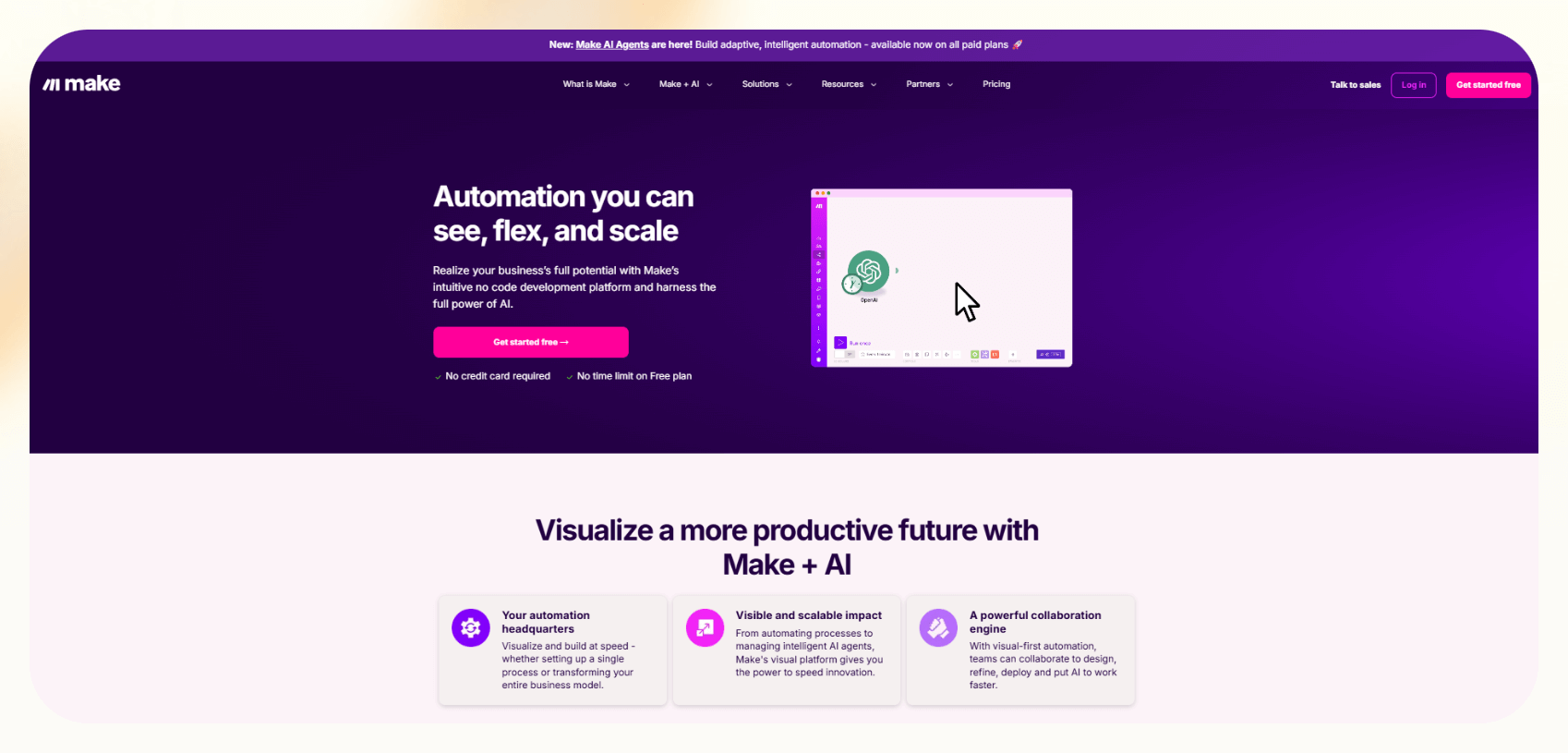
Make is a visual automation platform that lets users create workflows between apps without writing code. It's designed for non-technical users who want to connect tools, move data, and build lightweight logic-based systems.
You can drag and drop blocks to define what happens when a trigger event occurs. Make supports AI modules like OpenAI and Claude — and now offers native AI agent support as well. It now lets users inject intelligent decision-making steps or deploy lightweight agents within broader workflows.
It's handy for marketing, operations, and admin tasks.
Key features
- Visual workflow editor with multi-step branching
- Support for AI modules, routers, schedulers, and webhooks
- Version control, error handling, and execution logs
- Team collaboration tools and scenario scheduling
Integrations
- 2000+ app integrations (Google Suite, Slack, Airtable, Notion, Stripe, etc.)
- Webhooks and custom API modules for everything else
Pricing
- Free plan: 1,000 operations/month
- Paid plans start from $10.59/month, billed monthly
8. Suki AI – Best for clinical documentation and medical scribing
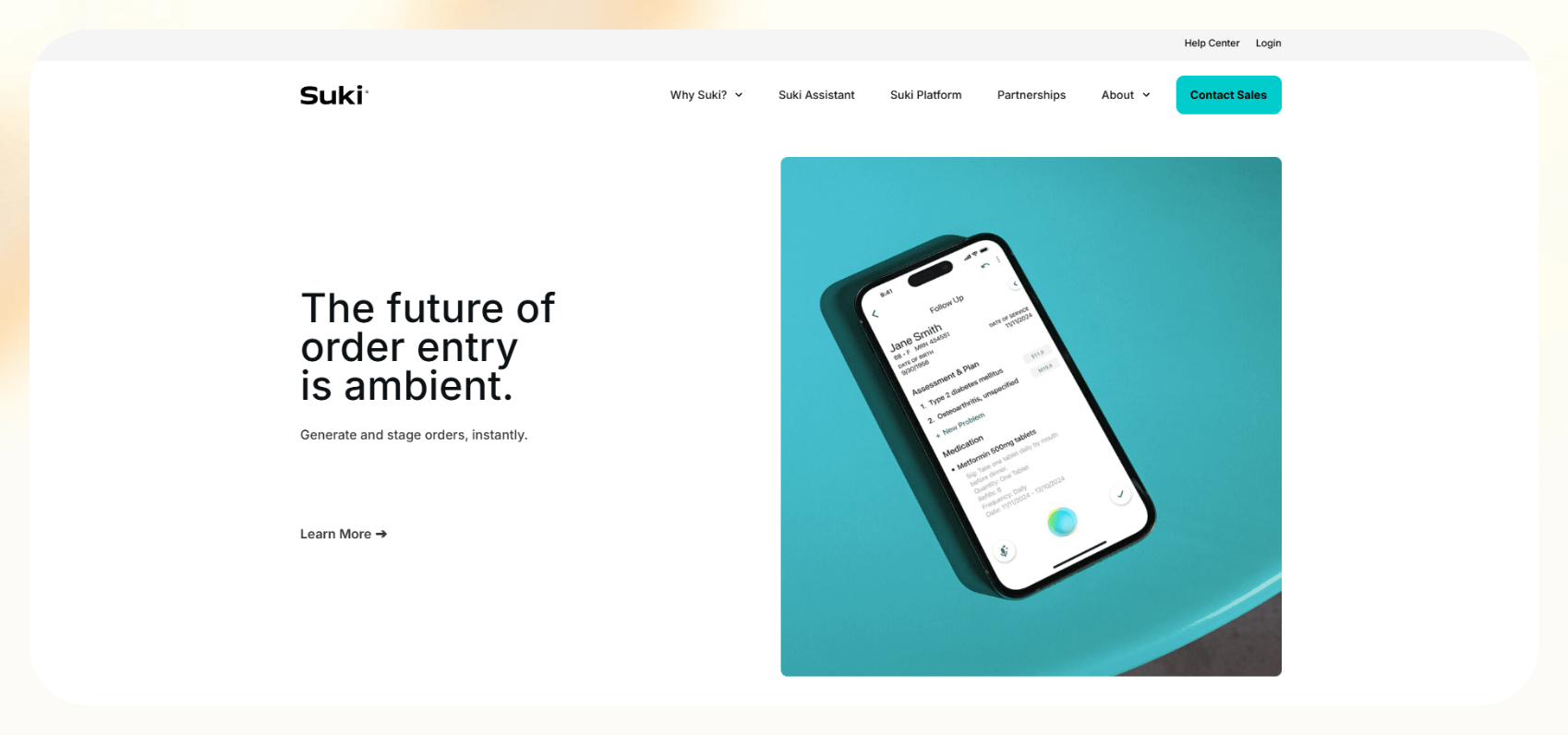
Suki AI is a voice-enabled digital assistant built specifically for healthcare providers. It helps doctors complete clinical documentation by listening to patient visits and generating medical notes in real time.
The system integrates with EHRs and uses natural language understanding to reduce manual data entry. Suki is designed to save clinicians time and reduce burnout by streamlining repetitive documentation tasks. It’s used in both outpatient clinics and large health systems.
Key features
- Voice-activated medical scribing
- Dictation and ambient listening modes
- EHR integration with structured data capture
- HIPAA-compliant, cloud-based infrastructure
Integrations
- Works with major EHR platforms like Epic, Cerner, and Athenahealth
- Supports mobile and desktop platforms for note review
Pricing
- Pricing not publicly listed, contact sales for detailed quote
9. Zendesk AI – Best for AI-powered customer support automation
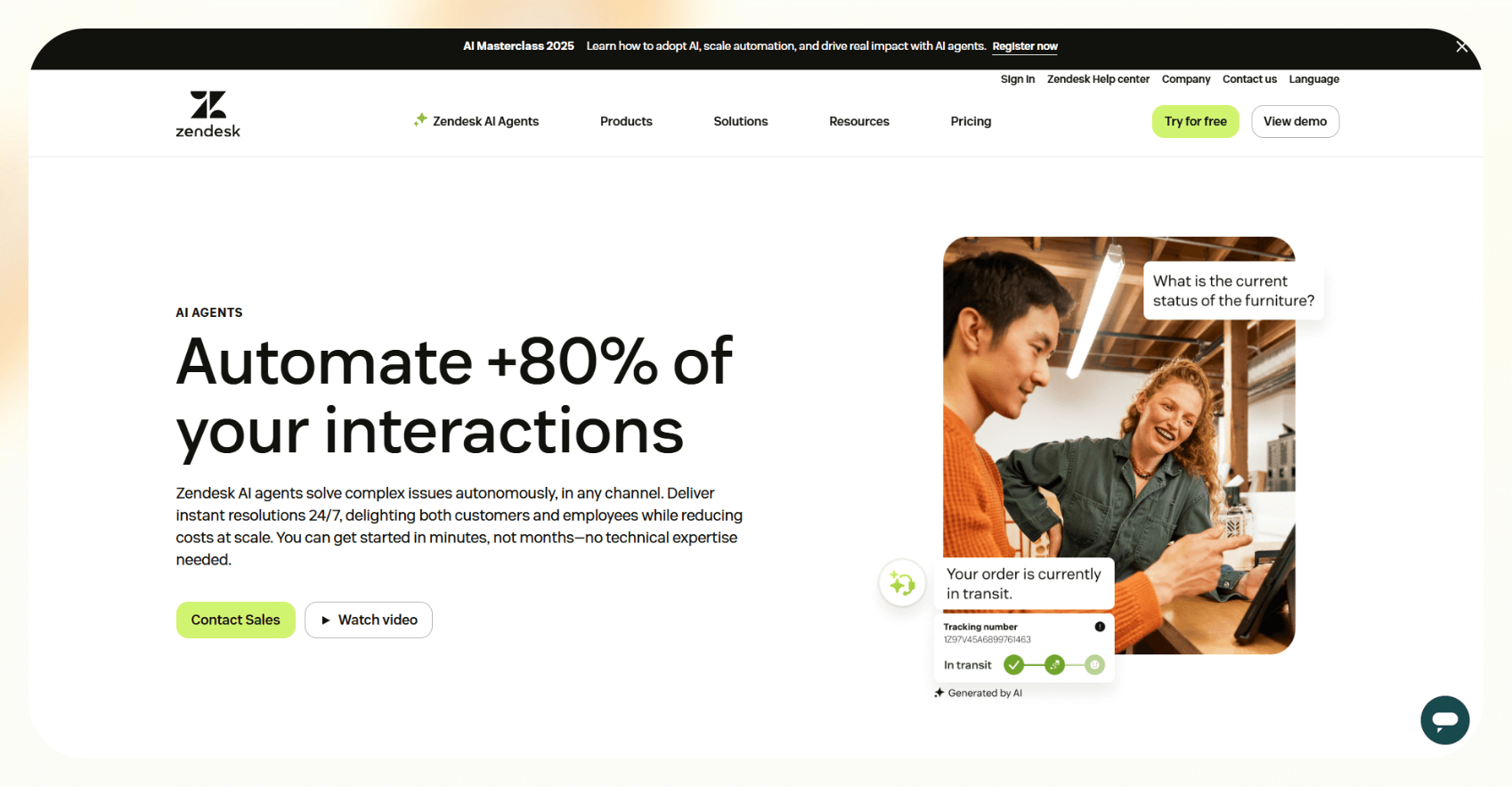
Zendesk AI is a customer support automation that helps CX teams deflect tickets and assist agents using AI. It powers chatbots and virtual agents across email, live chat, and messaging platforms.
Unlike rigid rules-based bots, Zendesk AI uses natural language processing to understand intent and respond with relevant answers. It can also assist your human agents by suggesting responses or automating repetitive actions.
It's widely used by support teams in retail, travel, fintech, and telecom.
Key features
- AI-powered virtual agents and agent assist
- Multilingual support for 40+ languages
- Intent detection and training workflows
- Analytics for performance monitoring
Integrations
- Integrates with hundreds of apps
Pricing
- Suite Team, the plan with AI agents, starts at $69/month, billed monthly
Next, we see what to look out for when selecting a vertical AI platform.
Avoid these common pitfalls when exploring vertical AI
As with any emerging tech, it’s easy to get caught up in the hype. Here’s what to watch for:
- Wrappers, not agents: Some tools are just thin interfaces over LLMs with no real ability to execute tasks or use memory.
- No memory: Without memory or knowledge base, agents lose context — which kills ROI.
- Limited action-taking: If an agent can’t update your CRM, send an email, or fetch external data, it’s not useful.
- Over-customization: Flexibility is good. But if a platform requires tons of setup to get basic tasks running, it's not scalable.
Look for AI agents that operate inside your workflows, especially across vertical platforms like CRMs, inboxes, or EHRs.
We’ve explored the tools and what to look for when looking for AI platforms. But is Lindy a true vertical AI platform? We answer that next.
{{cta}}
Is Lindy a vertical AI platform?
Lindy fits the definition of a vertical AI platform, although it’s not explicitly labeled as one. Its agents are built for specific roles — sales reps, recruiters, support agents, medical scribes — and they operate directly inside the tools teams already use.
What sets Lindy apart is how it handles task automation across different applications –– email, phone, CRM, calendar, and web. You can deploy an agent that responds to leads, books meetings, and updates your pipeline, all from the same flow.
Lindy supports multi-agent handoffs, memory, and tool execution, making it well-suited for outcome-focused teams. For teams looking to build AI agents that integrate with business processes, Lindy offers structure without complexity.
Frequently asked questions
How is vertical AI different from traditional SaaS?
Traditional SaaS provides software that humans operate. Vertical AI, on the other hand, uses agents that act on your behalf. Instead of giving you dashboards and forms, agents do the work — sending emails, updating CRMs, handling tickets — based on your goals.
Can I use vertical AI agents without coding?
Yes. Many platforms now offer no-code or low-code interfaces to build and deploy agents. You can use templates, visual editors, and integrations without needing to write scripts or prompts.
What are the best use cases for vertical agents?
Top use cases include lead follow-up, inbox triage, interview scheduling, medical charting, and campaign reporting — all tied to well-defined, repeatable workflows.
Try Lindy, your new vertical AI platform and way more
Lindy goes beyond basic automation or simple chatbots. Its AI agents are built to operate like teammates — ones that understand their role, tools, and goals.
Here's how Lindy goes the extra mile:
- Instant inbox support: Lindy tackles customer queries directly within your support channels or its dedicated inbox, delivering lightning-fast resolutions and boosting satisfaction.
- Always-on assistance: Lindy provides 24/7 support, ensuring customers never face frustrating delays.
- Conquering language barriers: With fluency in over 30 languages, Lindy’s phone agents expand your reach and open new markets.
- Effortless website integration: Add Lindy to your site with a simple code snippet, instantly enhancing visitor engagement.
- Plays well with others: Lindy seamlessly integrates with a plethora of tools (like Stripe and Intercom) for streamlined workflows and maximum efficiency.
- Scales to meet your needs: Lindy handles any volume of requests and even teams up with other instances to tackle the most demanding scenarios.
- Much more than just a chatbot: There’s a huge variety of Lindy automations, from content creation to coding. Check out the full Lindy templates list.





















.jpg)
.png)
.png)

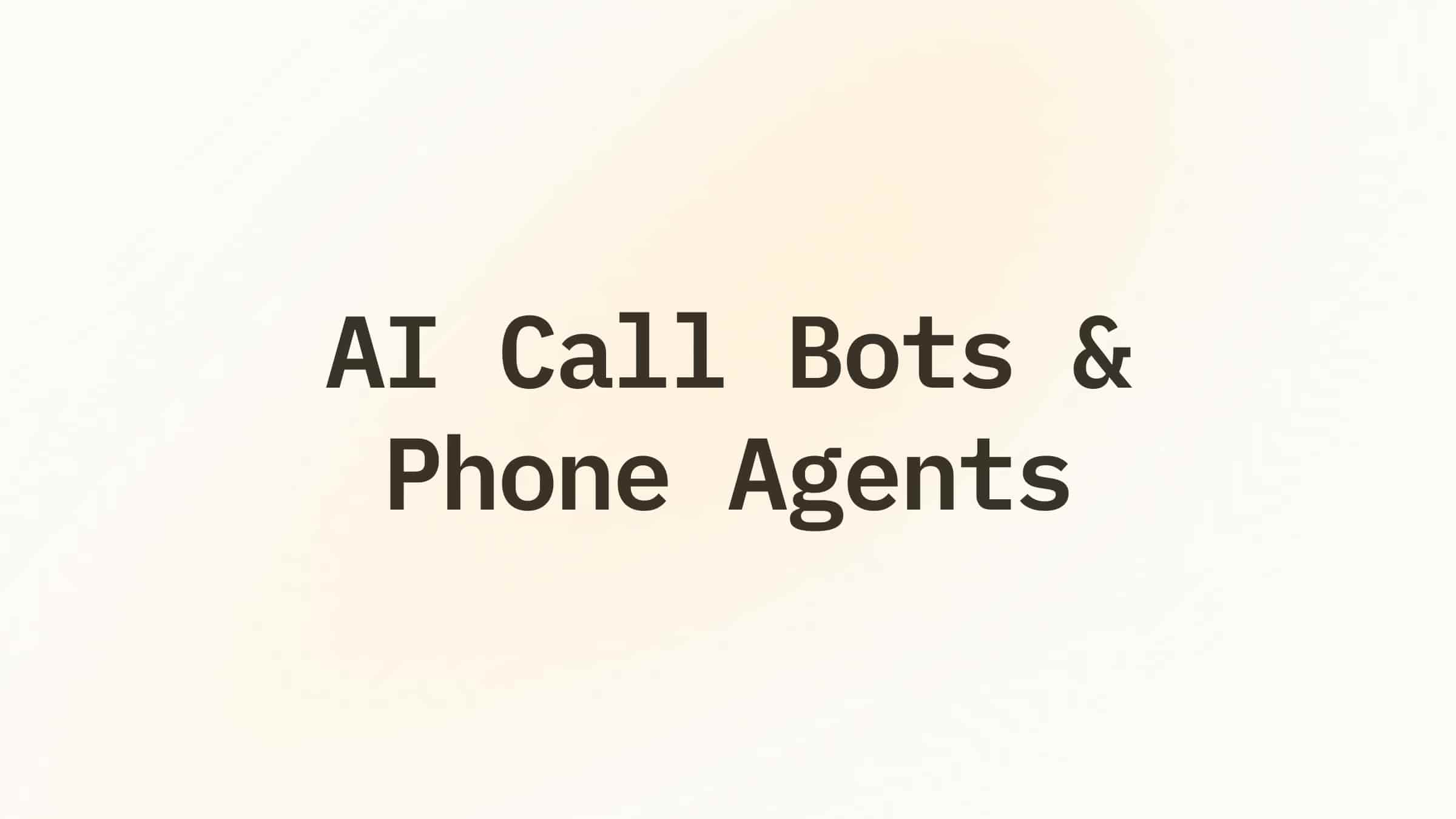
.png)
.png)